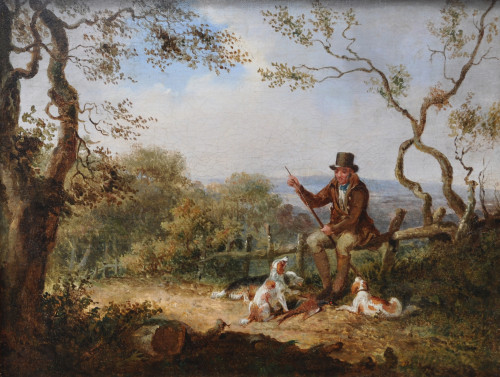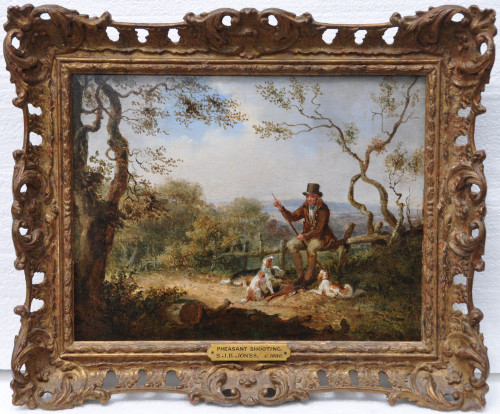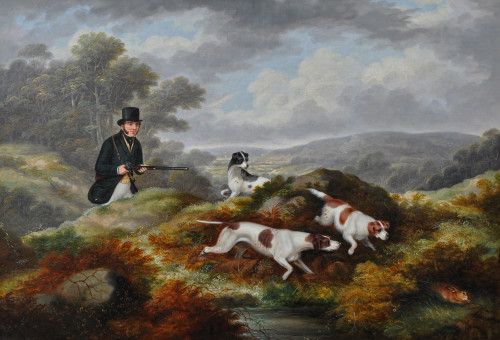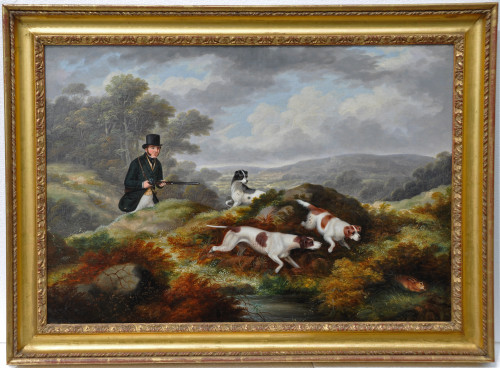Full cry, a hunting scene
Full cry, a hunting scene
SAMUEL SPODE
1798 -1872
English School
Full cry; a hunting scene
Oil on canvas, signed
110.7 x 141.3 cms
435/8 x 555/8 ins
Overall framed size 128 x 157.5 cms
503/8 x 62 ins
Samuel Spode was a painter of horses and dogs whose work is tinged with a naïve charm. He never exhibited at the major institutions but from private commissions gained a good living by portraying the hunters of clients, occasionally in the open but more commonly in their loose boxes. Besides the hunting fraternity he also received commissions from the racing world in both England and Ireland with such works as Berengaria with Herbert Brown up and a galloping Alice Hawthorn. Spode also received some commissions from the military and two significant examples are the depictions of Copenhagen, the Duke of Wellington’s war horse which was ridden at the battle of Waterloo and Lord Cardigan’s charger Ronald which was involved in the Charge of the Light Brigade in 1854.
Spode was the grandson of Josiah Spode (1733-1797) who was the founder of the eponymous pottery works in Staffordshire and gained international renown for its quality. He was born on 21st April 1798 and initially received legal training from his uncle with a view to practicing as a solicitor. He married Mary Crewe on 8th February 1821 and only a month or so afterwards, he, his wife and brother, Josiah and his wife, seized on the opportunity to take advantage of an incentive offered by the government to settle in Van Dieman’s Land (Tasmania) which was a penal colony. He worked for a while as a clerk in the Supreme Court of the colony but the appeal of life there must have waned for in the Hobart Town Gazette edition of 15th April 1826 an announcement appeared stating that: “Samuel Spode is leaving the colony by the ship Medway.”
Spode’s brother and wife remained – Josiah eventually becoming Principal Superintendent of Convicts - and upon Samuel’s return to England resided for a while in the near vicinity of the Mason Ironstone Works at Fenton in the Staffordshire Potteries with his sister Sarah and her husband. Whilst in Tasmania, Mary had been involved in a carriage crash and suffered head injuries. It could have been as a consequence of this that she died in 1827 and this experience of becoming a widower repeated itself a further two times as his third wife died when Spode was 40.
Whether the experiences of living in the southern hemisphere not being successful, the loss of his wife or a combination of the two, were the catalysts for him to change his life, is not recorded. However, it is apparent that even though he was still working as a lawyer, he forsook the profession to pursue his passion for painting with the clear intention of establishing a career as an artist and he started by painting the local environs as well as horses. One of these early works is described as Children in an Industrial Landscape which probably depict his daughter Mary and niece Florence Elizabeth Mason together with a pony and black dog. Another is Timbrells’s Yard.
In 1836 he travelled to Ireland to paint racehorses and garnered significant Irish patrons portraying some of the major winners of the time such as Birdcatcher, which was the first major Irish thoroughbred to win the Peel Cup at the Curragh on 21st October 1836 and Harkaway which was one of a small number of high class horses to be bred in Ulster.
During the 1830s, Spode made several more visits to Ireland to paint but he had become even more deeply involved in the racing world by working as a trainer at the Curragh Racecourse and this fact is recorded in a painting in 1856 by Samuel Henry Alken (aka Henry Alken Jnr) with the title S. Spode Training Eastern Bere. This work was sold at the Sotheby’s auction A Living Legacy: Irish Art From The Collection Of Brian P. Burns in November 2018 and the catalogue notes state that: Henry Alken portrays Samuel Spode, horse trainer and painter, training Eastern Bere at full gallop while watched on by an elegantly dressed couple, presumably the owners. 'Spode wears the blue sleeves and black body of the owner's silks and instead of a jockey's cap, wears a cream-coloured top hat.' (Daire O'Connell, America's Eye, op. cit., p.97).
The racehorse training did not interrupt his painting though and over 400 paintings have been recorded as being produced by him during his career. He was passionate about animal painting and most particularly anything equine related so producing portraits of racehorses or hunters, some with their owners, riders, jockeys or trainers, together with scenes of fox hunting, constituted the bulk of his output. He portrayed Voltigeur with Job Mason up, winner of both the Derby and the St. Ledger in 1850; Favonius (winner of the Derby in 1871) as well as an equestrian portrait of the Earl of Lonsdale on his old favourite Tempest. The racehorse Sam Spode, which he painted, was one of three Irish racehorses named after him and his family, the other two being Mrs Spode and Miss Spode. There is a self-portrait of him in hunting gear, mounted on a black horse with other huntsmen and hounds in the distance. In 1817 he painted Coursing at Stonehenge, a subject he reprised in 1845 with The Pinckney Family Coursing at Stonehenge.
Examples of his work can be seen in the Bradford on Avon Museum; National Trust at Florence Court; Salisbury and South Wiltshire Museum and the National Horseracing Museum. Two of his paintings were reproduced in The Sporting Magazine in 1825
Samuel Spode seems to have led a fairly peripatetic life and the loss of three wives could have been an impetus for moving around. There is a record of a poetic note to the master of the Kilkenny Fox Hounds which concludes with:
Having finish'd 'Dicks' picture, I'm so far explicit,
Other horses to pourtray, I beg now to solicit,
Or I must move off back to England I fear,
But I'd much rather stay, and be painting well here!
Although recorded as living in London in the census 1871, the year before his death, by the 1860s, he had been spending more time in Ireland, basing himself there to such an extent that in Dublin in 1865 he married a woman by the name of Delia. The fact that he claimed to be a bachelor to enable this union, although he was in fact married to his fourth wife in England at the time, throws some light on a somewhat cavalier approach to life. He was back in Ireland in 1872, and his death in Dublin is recorded as 31st March 1872. He left several children from his five marriages and although his death was registered by Teresa Spode, Delia inherited what was left of his estate.
Bibliography:
The Dictionary of British Equestrian Artists – Sally Mitchell
Spode History: Biography of Samuel Spode – Peter Roden
A Dictionary of British Animal Painters – J C Wood
Sotheby’s
RELATED ITEMS























